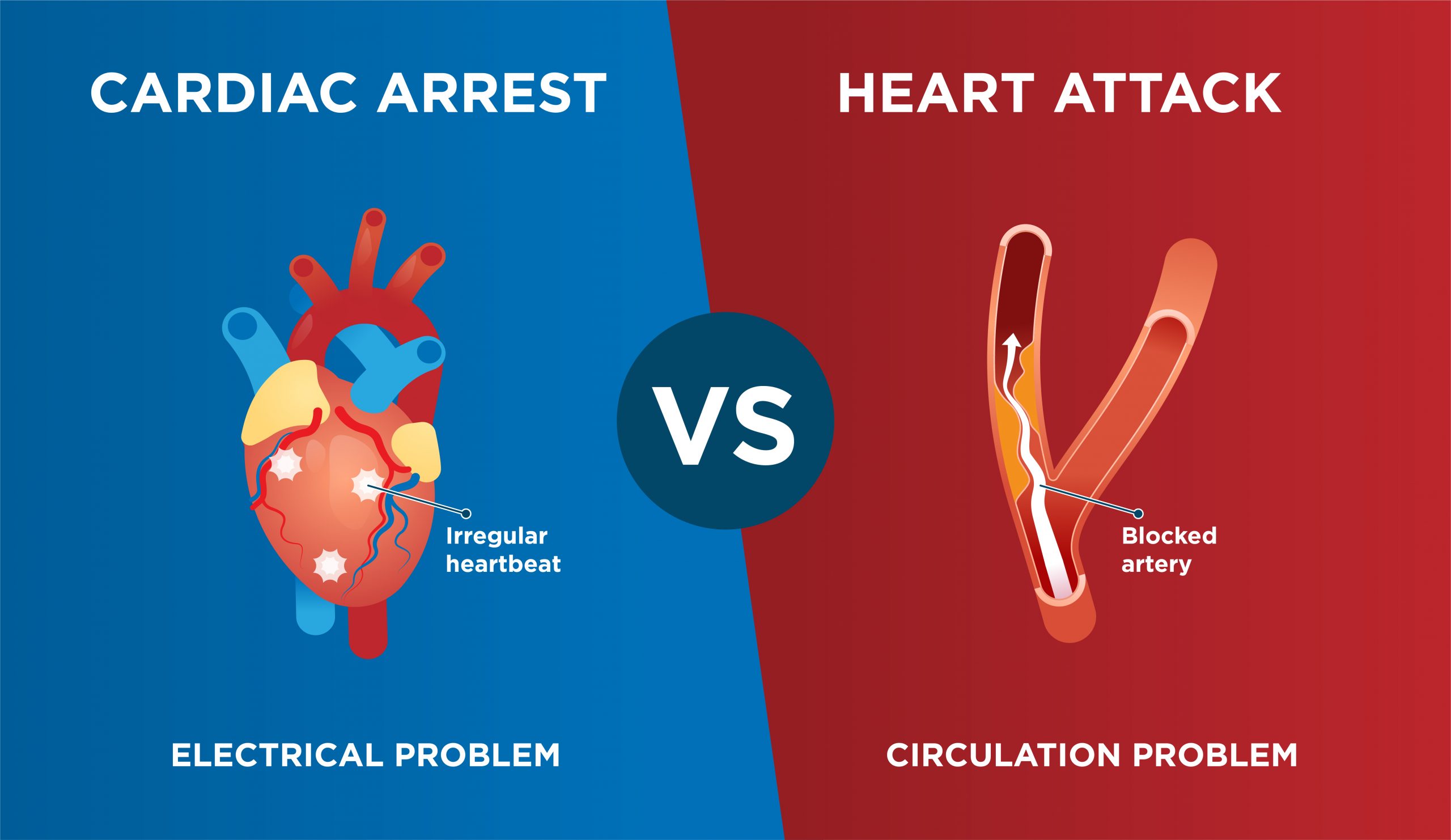Often, these terms are used interchangeably, but they refer to different medical conditions.
What is a Heart Attack?
A heart attack occurs when a blockage in an artery restricts blood flow to a part of the heart, causing that area to be deprived of oxygen. If the blockage isn’t quickly addressed, the affected portion of the heart tissue can die.
Symptoms of a heart attack can vary, ranging from sudden and severe to mild and gradual. It is important to note that some individuals may experience mild symptoms or even no symptoms at all and still be having a heart attack. The heart attack symptoms in women can be different than in men.
Unlike with sudden cardiac arrest, the heart usually doesn’t stop beating during a heart attack. It is essential to recognize the differences, as the symptoms and treatment approaches for each condition can vary significantly.
Related: Heart Attack | 11 Frequent Questions and Answers

What is Cardiac Arrest?
Sudden cardiac arrest typically happens unexpectedly and without prior warning. It results from an electrical malfunction in the heart, causing an irregular heartbeat known as arrhythmia. This disruption in the heart’s rhythm prevents it from effectively pumping blood to vital organs like the brain and lungs.
Consequently, the individual loses consciousness and their pulse ceases. Without prompt medical intervention, death can occur within minutes.

The Connection Between Heart Attack and Cardiac Arrest
The relationship between these two distinct heart conditions is significant. Sudden cardiac arrest may occur either following a heart attack or during the recovery phase. Heart attacks elevate the risk of sudden cardiac arrest, although not all heart attacks immediately lead to it. However, when sudden cardiac arrest does transpire, a heart attack often serves as a common trigger.
Additionally, various other heart conditions can disrupt the heart’s rhythm, potentially leading to sudden cardiac arrest. These include cardiomyopathy (thickened heart muscle), heart failure, arrhythmias—especially ventricular fibrillation—and long Q-T syndrome.
Related: Heart Diseases | What you Need to know?
What to do in the Case of Heart Attack?
Even if uncertain whether it’s a heart attack, dial 911 or your local emergency response number. Time is critical! Contacting Emergency Medical Services (EMS) ensures swift transportation to the emergency room. EMS personnel can initiate treatment upon arrival, potentially saving up to an hour compared to traveling by car to the hospital.
Additionally, EMS staff are equipped to administer resuscitation to individuals experiencing cardiac arrest. Those arriving by ambulance with chest pain may also receive expedited care at the hospital.
What to do in the Case of Cardiac Arrest?
For adults, the first step is to check for responsiveness and then call out for nearby assistance. Subsequently, dial 911 to activate emergency medical services. If an automated external defibrillator (AED) is accessible, retrieve it and use it promptly upon arrival.
Commence high-quality cardiopulmonary resuscitation (CPR) immediately and sustain it until professional emergency medical services arrive. If there are two individuals available to assist, one should start CPR right away while the other contacts 911 and locates an AED.
In the case of children and infants, airway obstruction frequently triggers cardiac arrest. Promptly calling 911 to summon emergency responders should be followed immediately by the initiation of high-quality CPR. If aid is nearby or a cell phone is accessible, activating the emergency response and commencing CPR can be nearly simultaneous.
However, in situations where a single rescuer lacks access to a cell phone, it is advisable to begin CPR (compressions-airway-breathing) before seeking help elsewhere, as respiratory arrest is the primary cause of cardiac arrest and assistance may not be close by. If the individual has suddenly collapsed, rescuers should utilize an AED, as early defibrillation can be life-saving.
Sudden cardiac arrest stands as a leading cause of death, with approximately 350,000 out-of-hospital cardiac arrests occurring annually in the United States. Performing Hands-Only CPR to the rhythm of the classic disco song “Stayin’ Alive” can potentially double or even triple a victim’s likelihood of survival.
Bottom Line
Heart attacks and sudden cardiac arrests are distinct but often confused conditions. A heart attack results from blocked arteries, hindering blood flow to the heart. Symptoms vary, and it’s crucial to seek immediate medical attention. In contrast, sudden cardiac arrest arises from heart electrical malfunction, requiring swift CPR and AED use to prevent fatalities.
